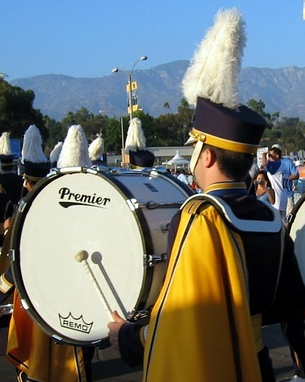Lesson 18
Volume and Graphing
- Let’s use volume and graphing to solve problems.
18.1: Parade Balloon: Part 1
A company makes giant balloons for parades. They’re designing a balloon that will be a dilated version of a drum similar to the one in the image. The real-life drum’s diameter is 36 inches and it’s 1 foot wide.

- What’s the approximate volume of the real-life drum in cubic feet? Round to the nearest hundredth.
- Suppose the drum is dilated by scale factor \(k\). Write an equation that gives the volume, \(V\), of the dilated drum.
- What are some reasons the actual drum volume might be different from what you calculated?
18.2: Parade Balloon: Part 2
A company makes giant balloons for parades. They’re designing a balloon that will be a dilated version of a drum with diameter 36 inches and height 1 foot. The balloon will be inflated with a gas called helium. The balloon designers want to be able to find the scale factor they can achieve with different volumes of helium.
In an earlier activity, you found the volume of the original drum, and you wrote an equation to describe the volume, \(V\), of a version of the drum that had been dilated by a factor of \(k\).
- Rearrange your equation to solve for \(k\).
- Use graphing technology to graph your rearranged equation. Set the viewing window to show a maximum of about 15,000 cubic feet on the \(x\)-axis.
- The point \((1,\!000, 5.21)\) is on the graph. What does this point mean?
- One tank of helium contains enough gas to fill 500 cubic feet of space. Suppose the company can afford 12 tanks.
- What scale factor can they use?
- What will the diameter of the balloon be?
- The company received a donation that will double the number of helium tanks they can afford. How will this change the diameter of the balloon they can create?
- The company learned that the parade route has size restrictions. The balloon can be no more than 15 feet in diameter.
- What scale factor would they need to get this diameter?
- What would the volume of the balloon be in this case?
- How many helium tanks would be required?
18.3: Beach Ball Balloon
The parade balloon company will make a second balloon, modeling a beach ball with radius 1.5 feet. The volume of the original beach ball is about 14.14 cubic feet.
- Explain why the equation \(k=\sqrt[3]{\frac{V}{14.14}}\) gives the scale factor \(k\) needed to achieve a dilated volume of \(V\).
- The applet contains graphs of the equations \(k=\sqrt[3]{\frac{V}{7.07}}\) and \(k=\sqrt[3]{\frac{V}{14.14}}\), which show the relationship between volume and scale factor for the drum and the beach ball. There is a horizontal line on the graph that can be moved up and down with a slider. What do points on the horizontal line represent?
- The company wants the two balloons to have the same scale factor.
- If the scale factor is 5, how much helium will they use in total?
- How much helium will they use if the scale factor is 10?
- Suppose the company purchases a total of 12,000 cubic feet of helium.
- About what scale factor should they use if they want to use all their helium and have the same scale factor for each balloon?
- What will be the approximate radius of the scaled beach ball in this case?
- Write an expression that gives the ratio of surface area to volume of a sphere with radius \(r\).
- Create a graph with the sphere’s radius, \(r\), on the \(x\)-axis and the ratio you wrote on the \(y\)-axis.
- Describe the shape of the graph for small radii.
- Describe the shape of the graph for large radii.
Summary
Suppose a farm has a water tank shaped like a cone. Water is poured in from the top, and a valve can be opened to let the water flow out the bottom. There is currently a small volume of water in the tank. The section of the cone that is filled has radius 1 foot and height 1 foot.

Using the expression \(\frac{1}{3}\pi r^2 h\), we find that the volume of water in the tank is about 1.05 cubic feet because\(\frac{1}{3}\pi (1)^2 (1)\approx 1.05\). As more water is poured into the tank, the shape of the water will be a dilation of the original small cone. An equation that expresses the volume, \(V\), in terms of the scale factor of dilation, \(k\), is\(V=1.05k^3\). This equation can be rearranged, resulting in \(k=\sqrt[3]{\frac{V}{1.05}}\). Here is a graph of the rearranged equation.

The point \((100,4.57)\) on the graph tells us that if the farmer puts 100 cubic feet of water in the tank, the scale factor of dilation will be 4.57. That means that the height of the water would be the original height of 1 foot times the scale factor 4.57, or 4.57 feet.
Glossary Entries
- density
The mass of a substance per unit volume.